
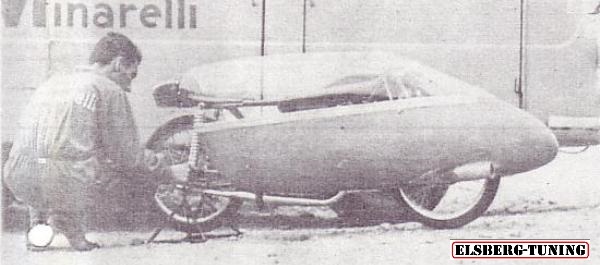
World records with 50 cc bikes.
Record bikes - year by yearArrigo Remondini rode this Remondini 50 to a speed of 96 km/h. "About Arrigo Remondini. I met him a few times in the 70s while researching his father, Guiseppe, French motorcycle company, the Jonghi.The photo of Arrigo on the 50cc moped can't be much after 1950 and is most probably late 40s. Looking at the name "Floquet" on the track side ads, a French make of spark plugs, means the place can only be the Montlhery track near Paris. Furthermore, Guiseppe lived about 5 km from the track in a little village, Torfou par Chamarande, while Arrigo another 3 km away in Chamarande itself. This Jonghi moped is very rare, in fact like all the Jonghi are, it never was a volume manufacturer and went on from 1930 till 1959 from bankrupty to bankrupty every 2 or 3 years! The french big manufacturers (Motobecane, Terrot, Peugeot) managed to upset all the small racing boys by forcing the FFM to forbid all racings of 50cc and 125cc from 1948 up till about 1958. So a full record attempt with this 50cc was never done. But the speed you mention rings a bell, I remember Arrigo talking about this real fast moped straight out of the workshop! I think the design was sold in Italy and a lot of the Italian 50s and 60s 50cc engines looks like this one! The Jonghi works closed definitively when Guiseppe died in 1959. Arrigo continued in the racing business. He became Jean Pierre Beltoise's mechanic, car and bikes, and followed J.P. to Matra and went on working an an engineer on the famous Formula 1 and Le Mans cars' 3 litres DOHC V12 engines. He died in the late 70s or very early 80s." Patrick Delli 2013 |
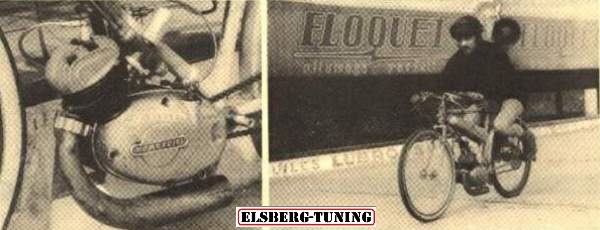 |
1951 |
|
| In 1951 the Victoria Werke attempted to exceed all previous records with this streamlined bike. Rider Georg Dotterweich managed a speed of ? | 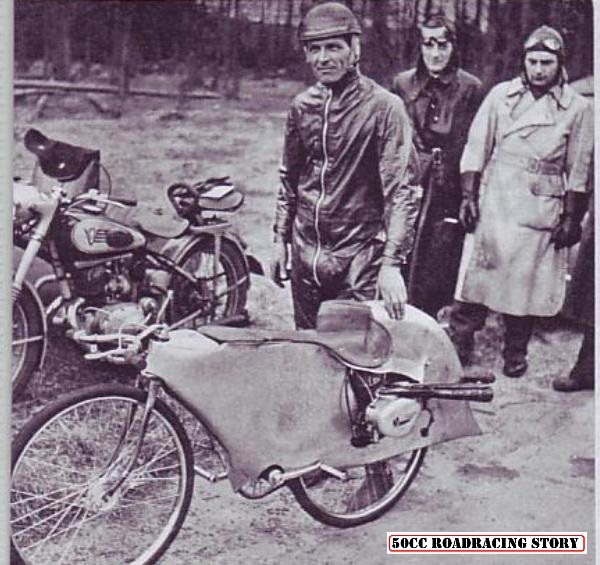 |
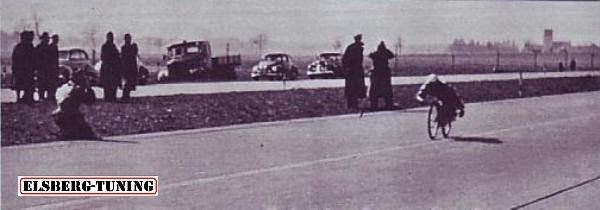 |
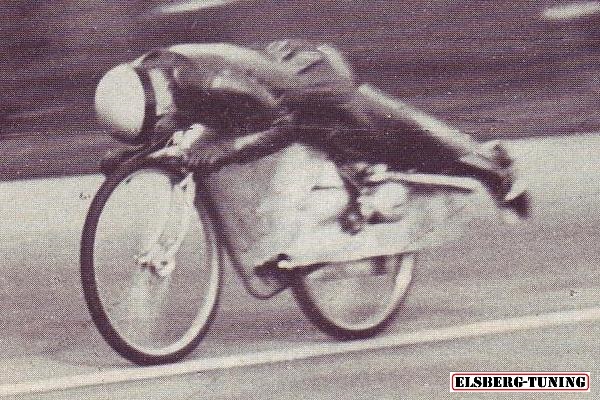 |
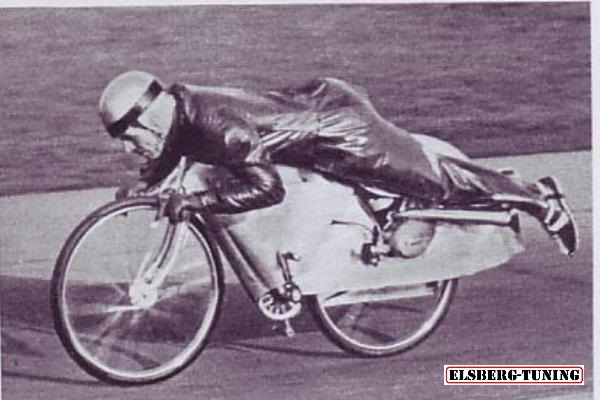 |
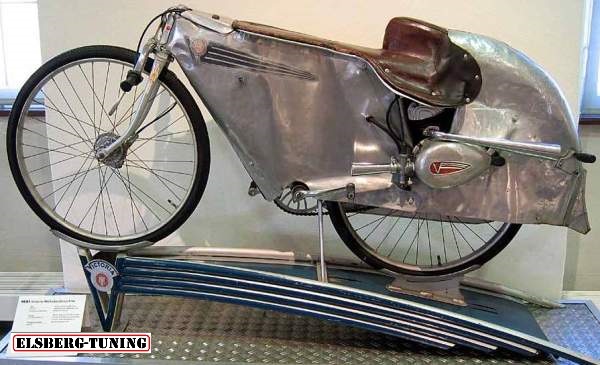 |
Also in 1951 a record was set by Italian Ugo Tamarozzi riding a 4- stroke Cucciolo (Ducati). The lightweight bike reached an average speed of 66,411 km/h over 24 hours and the 48 hour average was 63,209 km/h. Another attempt in 1952 made the Cucciolo reach 77,753 km/h in the 1000m - flying start category. |
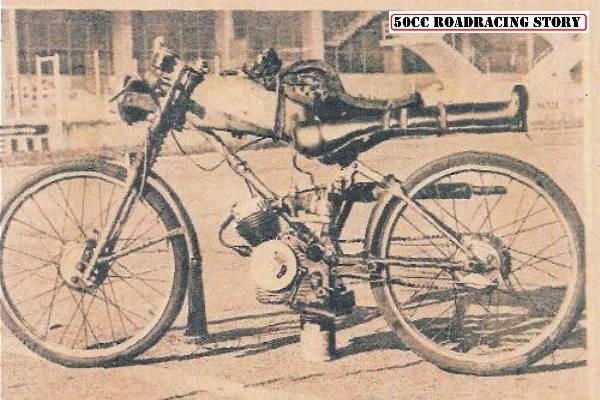 |
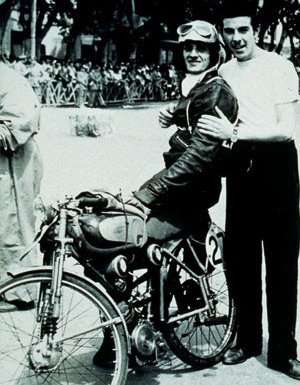 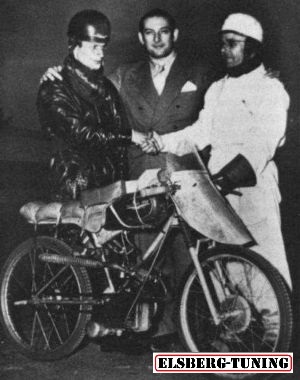 |
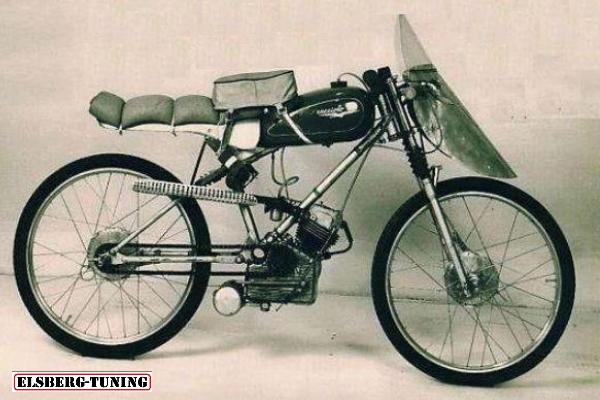 |
1954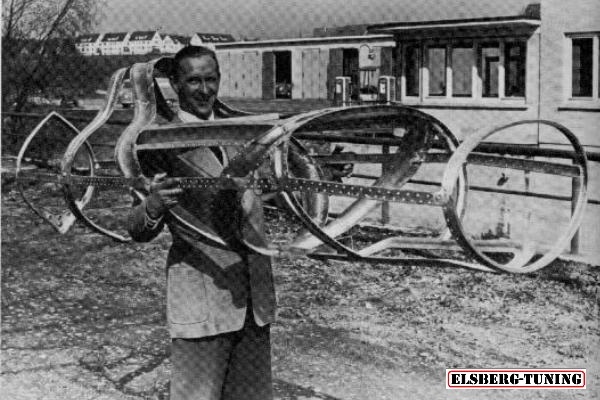 |
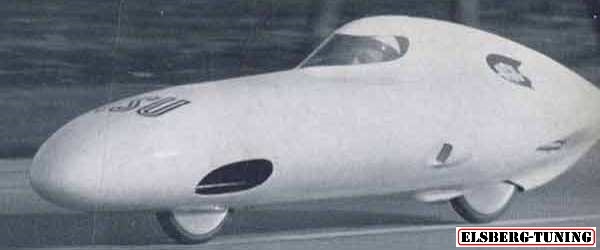 NSU made a series of land speed record vehicles, all designed and build by Gustav Adolf Baumm. It was competing in many classes, and in 54 a 3,4 hp 49cc 2-stroke took the Baumm I to 127 km/h. |
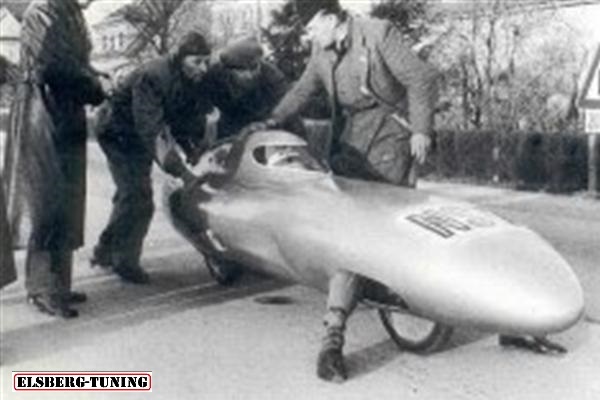 |
|
1955 | |
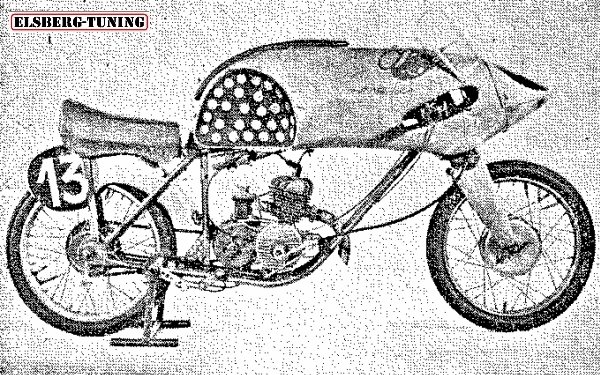 |
The 48cc 4-stroke powered Alpino broke some records on the Monza circuit : A 500km average of 71,2km/h
and a 3hr average of 82km/h Below Vaifro Meo designed streamlining 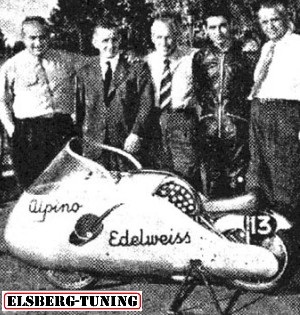 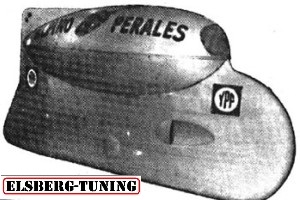 |
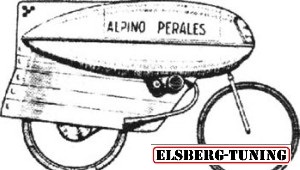  |
Vaifro Meo took the Alpino to new records in Buenos Aires : 1000m standing start: 76km/h, and 1 mile standing start: 77km/h.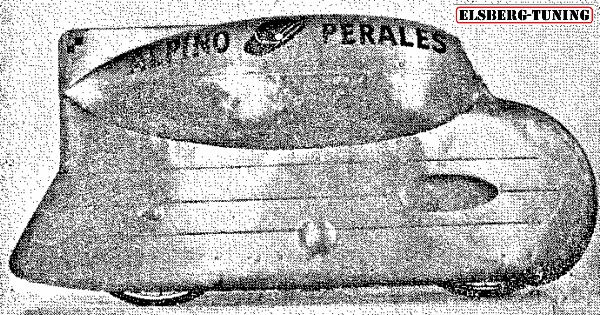 |
Aermacchi tried with this Lino Tonti designed streamliner, to set new records in the 50 and 75cc categories. The windtunnel of the Aermacchi aircraft division, were used to create this streamliner, and power came from a double overhead cam single. The 48cc 4-stroke had a bore and stroke of 40x39mm, and delivered 7hp at 12000rpm, to the 18" wheels through a 4- speed transmission. Springtime 1956, Massimo Pasolini did break records, at an autostrada near Milano. 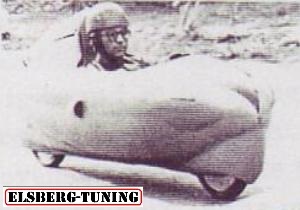
|
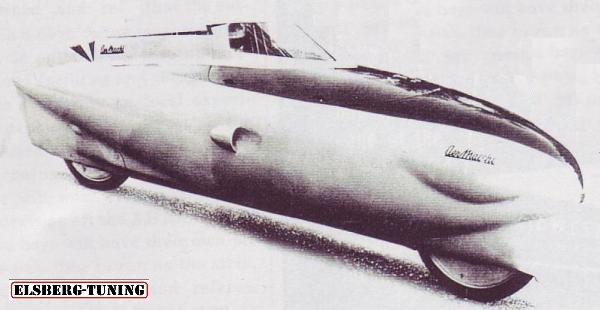 |
1956In 56 NSU visited Bonneville Salt flats, bringing the Baumm II, and now a supercharged 13,5 hp 2- stroke, powered rider H P Müller to 196 km/h. |
|
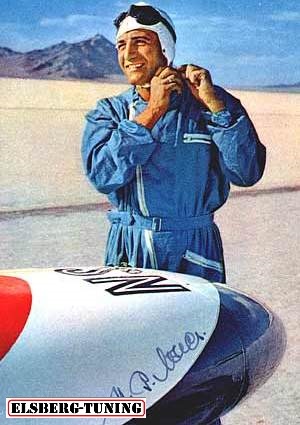 |
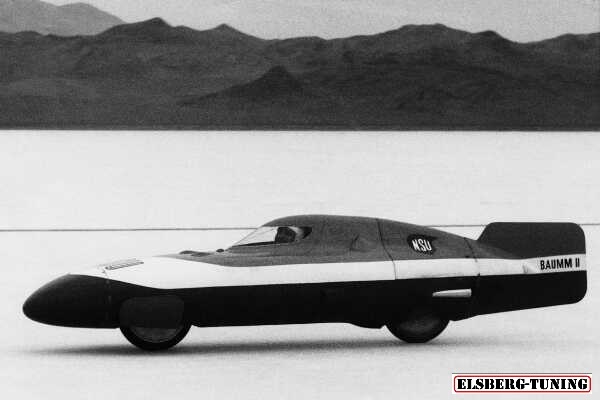 |
1958Italian Armando Pessina used a Motom for recordbreaking on the Monza racetrack in 58. The 4,5hp 4-stroke managed an average speed of 82,7km/h over 12hours, and 88,8 over 24hours. 1000m speed with standing start was 82,4km/h. |
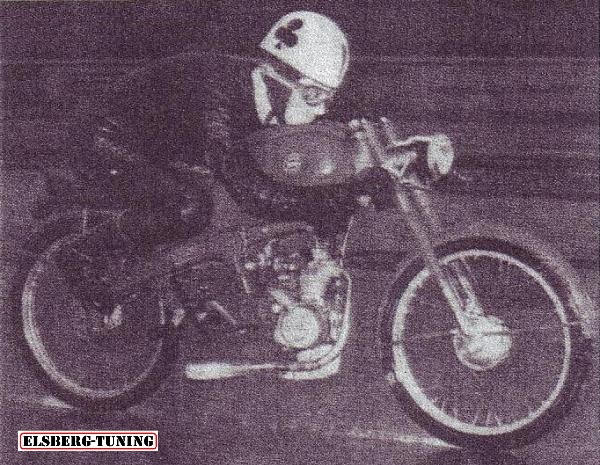 |
1959Demm1 and 2 show the record breaking Demm of 1959. Riders were Eraldo Tonelli, Piero Bernardi, Bruno Jacopini and Giuliano Franchi. The record over 1000 km was 98.8 km/h, and over twelve hours it was 99.3 km/h. The engine was a two stroke (Demm was mostly known for its lovely little four stroke engines), with a bore of 41.3 and a stroke of 37.1 mm. Power output was 4.5 bhp @ 9000 rpm. Here, again, no expansion pipe! J.Kortekaas 2006 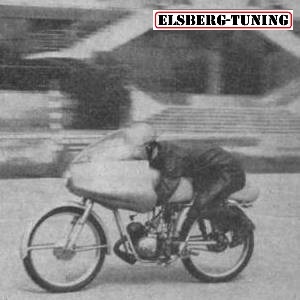
|
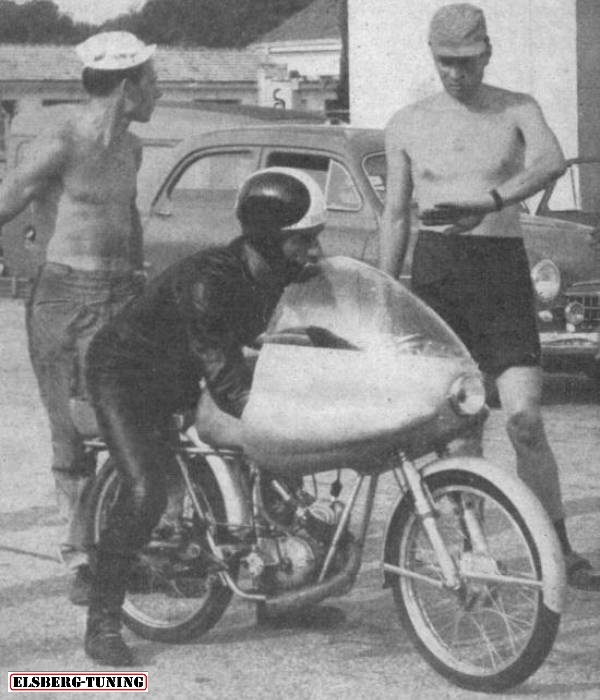 |
Another record bike from 1959, the Sterzi powered streamliner, the creation of Giuseppe Anfossi. |
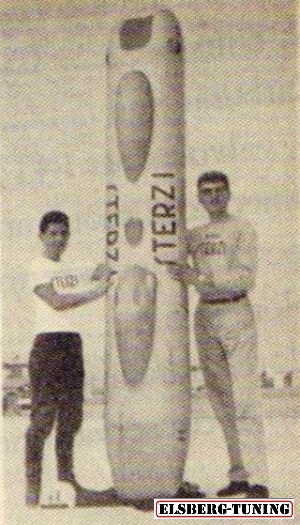 |
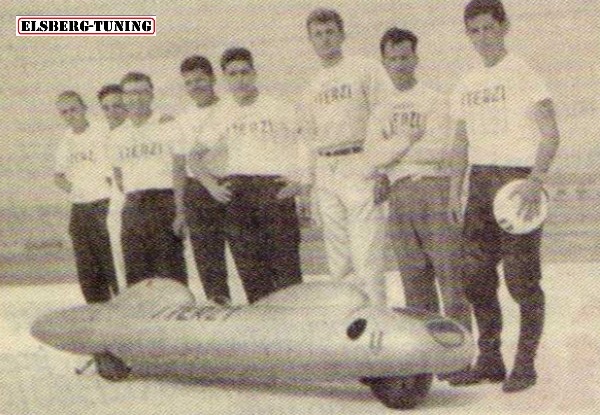 |
The Sterzi streamliner was 280cm in length, 47cm high, width 45cm, axle- axle 187ccm, and had 2.25x12" wheels. Anfossi modified the Sterzi Pony 4- stroke engine, raising compression to 11.5: 1 and an 11800rpm redline. The record attempt took place on the rather short stretch of Las Palmas, which was believed to limit topspeed to 138.993km/h. |
1963On the Monthlery track a french team, beat the 12 hour record now averaging 113 km/h. Engine : Vap Sachs, rider: Jean Pierre Beltoise. 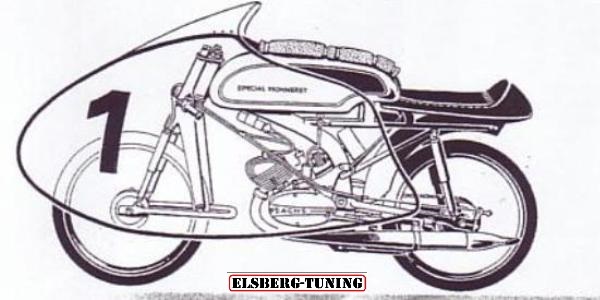 |
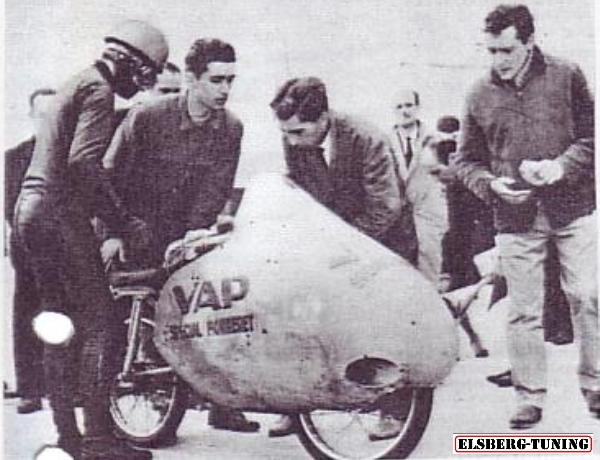 |
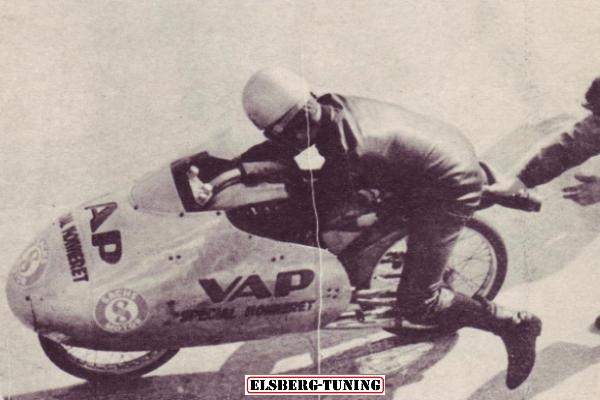 |
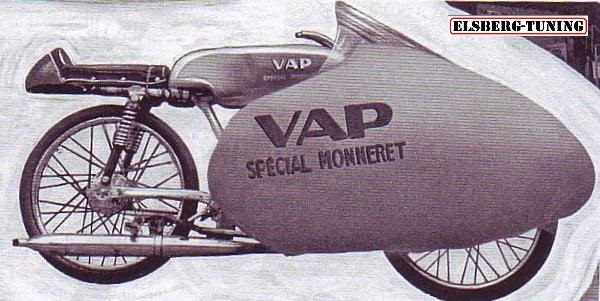 |
| November same year, the Garelli factory turned up at the Monza Autodrome. The six riders were : Marchesani, Pastori, Patrignani, Pernigotti, Spinello, and Zubani. The engine, a much modified Garelli Junior 2-stroke 40x39mm were strong enough to retrieve a number of records. |
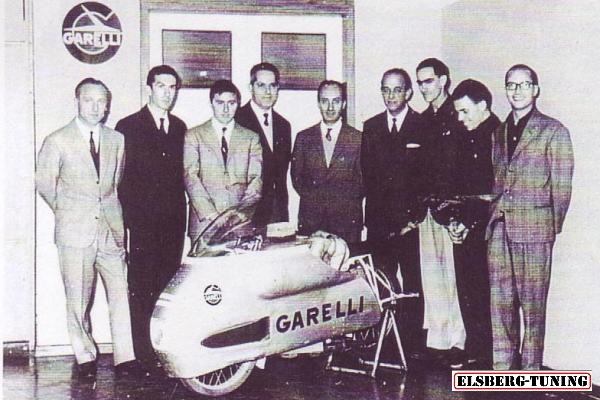 |
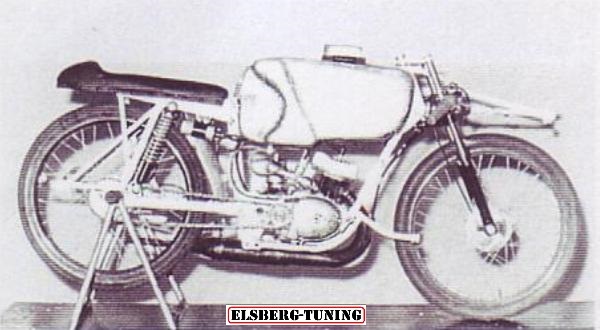 |
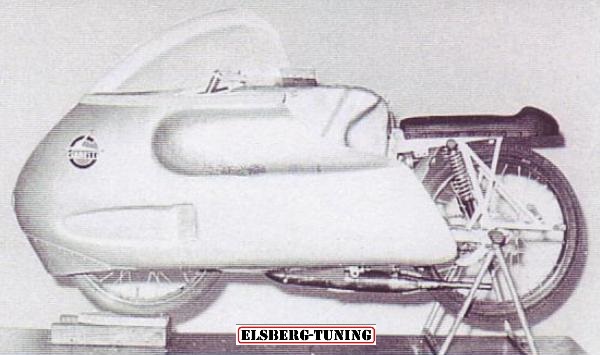 |
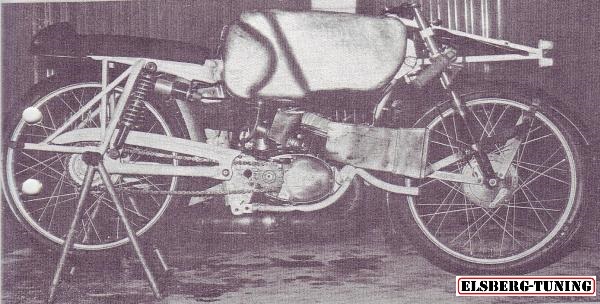 |
Average speed achieved over 6 hours : 121km/h, 1000km average : 117, 24 hour average : 109km/h. |
1964 |
|
| Americans used the Garelli engine too and Alan Richards created this SCTA Class I streamliner. Miniscule in appearance and the cramped interior made the builder name it Claustrophobia! The streamliner was build from a wing tank, and running the Garelli engine on methanol, made it produce around 10hp. Driven by Warren Roll the little bug reached a speed of 55,62 mph. | 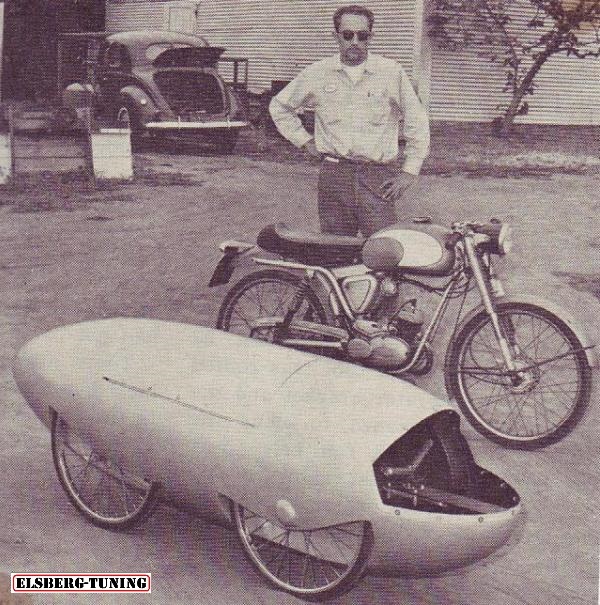 |
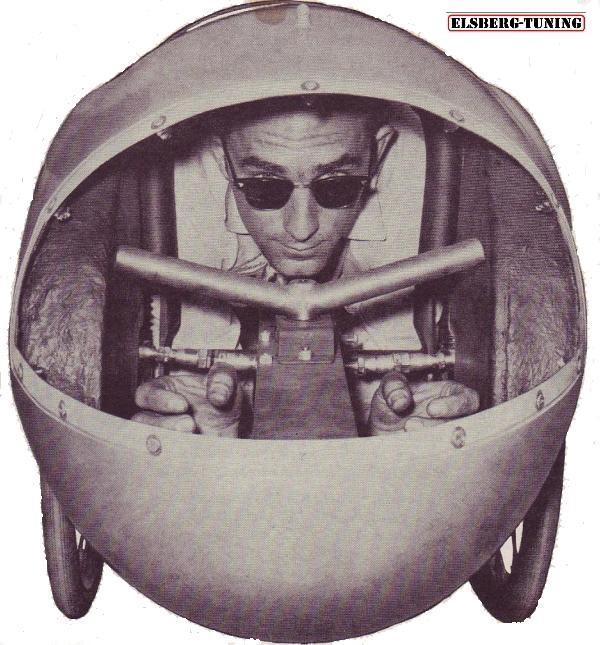 |
|
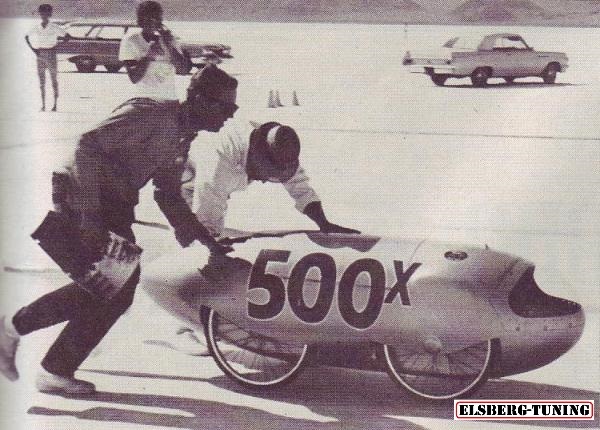 |
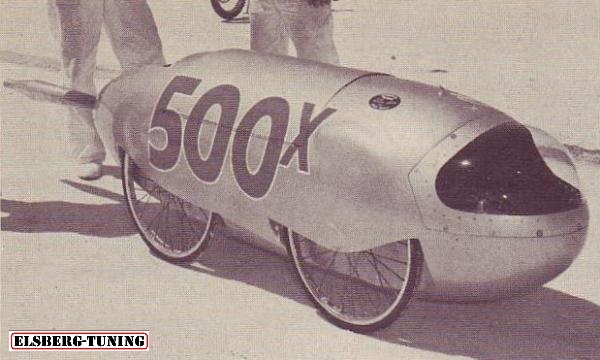 |
| November 64 at the Monthlery 2,5 km oval, Kreidler turns up with a strong team, determined to set new records. Riders: Hans Georg Anscheidt, Rudolph Kunz, Cees VanDongen, and spare Claude Vigreux, who was needed when Kunz chrashed during practice. The bikes had special fairings and the dual carb GP- engine was optimised for high speed. They went home with 8 new records, some of them beating both 50 and 75cc records. |
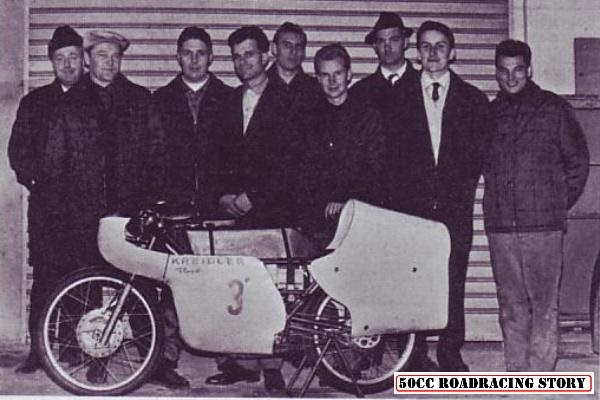 |
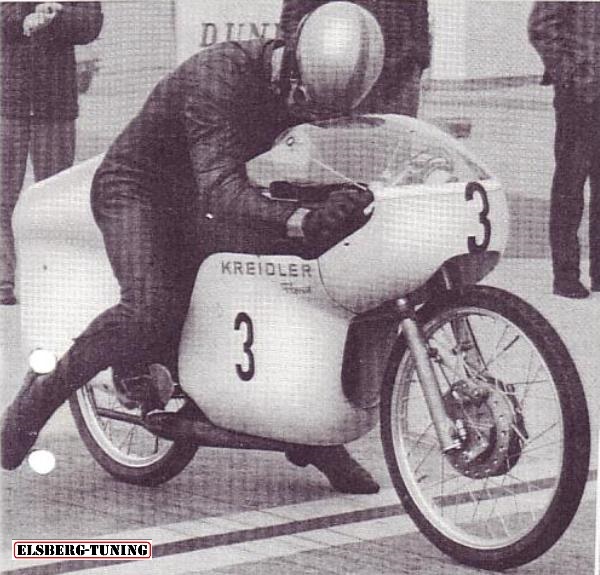 |
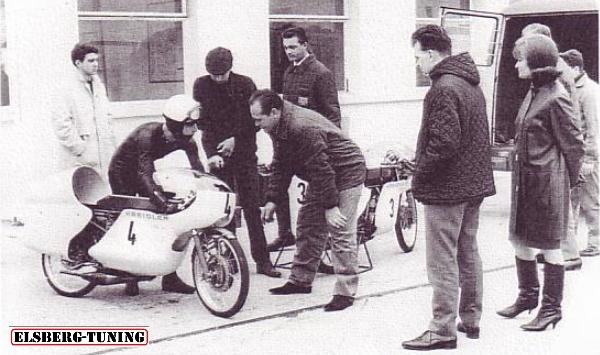 |
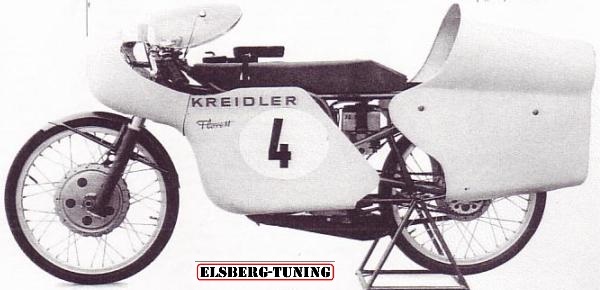 |
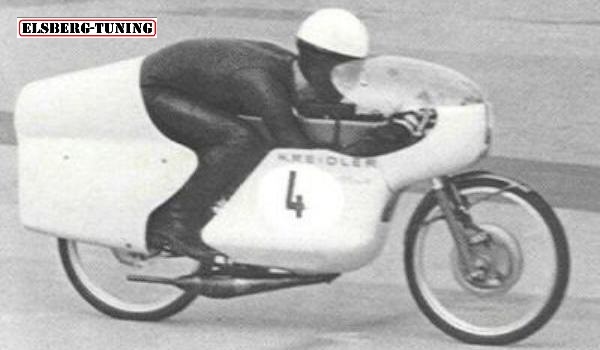 |
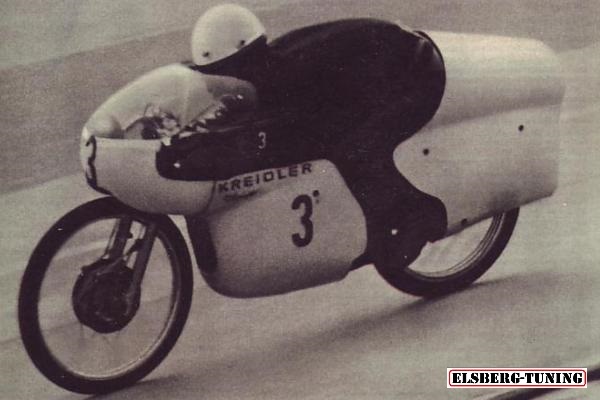 |
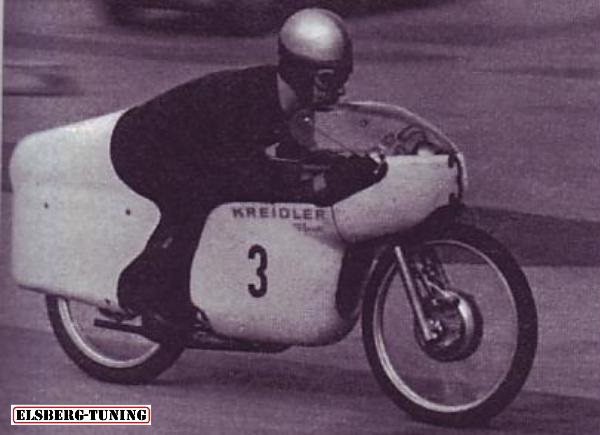 |
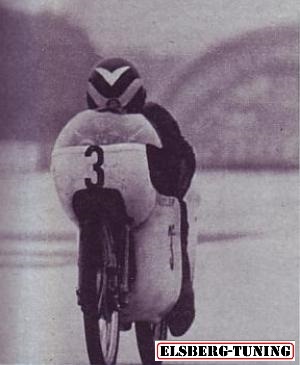 |
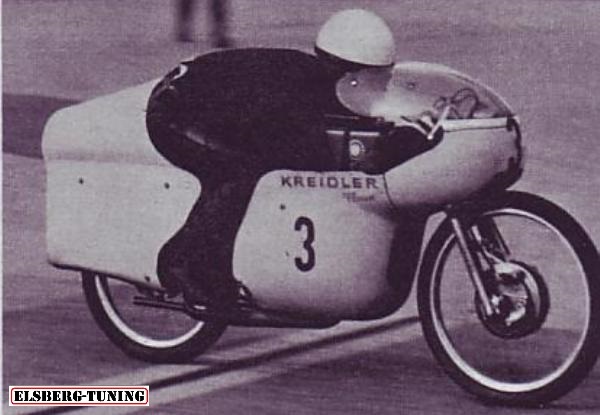 |
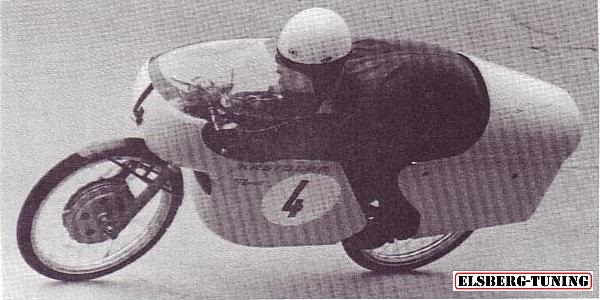 |
1965Three more records were broken in april 65 at the straight of Hochenheim. For these records demanding a standing start, a 47 kg lightweight was assembled and rider was tiny Anscheidt. Result: 1000m- standing start was covered in 32,58 sec. an average of 110,49. |
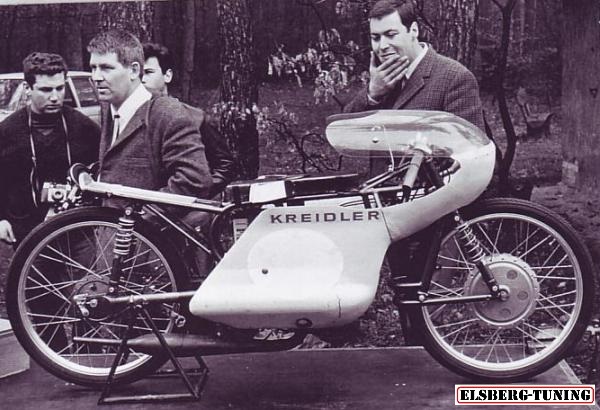 |
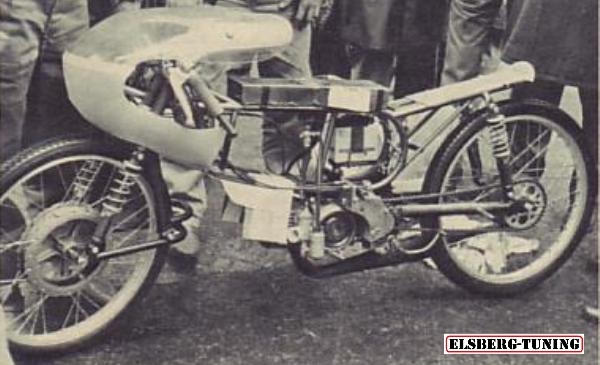 |
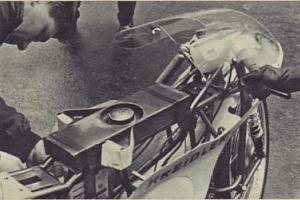 |
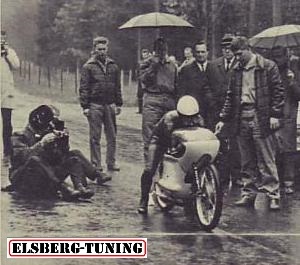 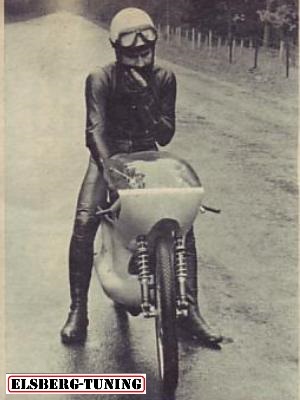 |
There were of course other manufacturers who wanted a piece of the pie, and one of them was German Zündapp. During 1965 they built a special record breaker (see pics Zundapp1 and 2) and although the weather at Monza was not very good (why are so many record attempts so often plagued by bad weather?) during 12, 13, 14 and 15 May 1965, riders Andreas Brandl, Volker Kramer, Peter Eser, Günter Sengfelder, Heinrich Rosenbuch and Alfred Lehner broke the existing records. |
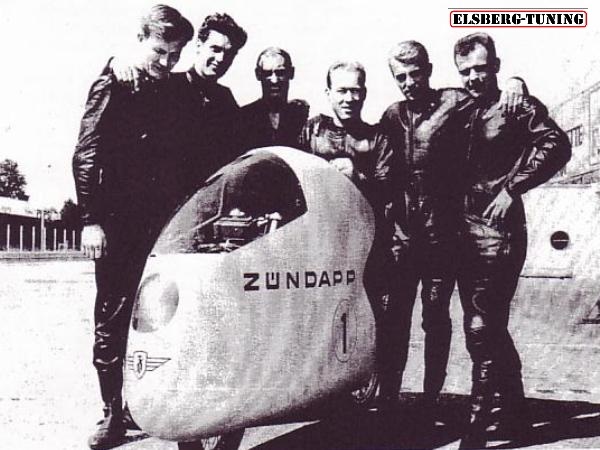 |
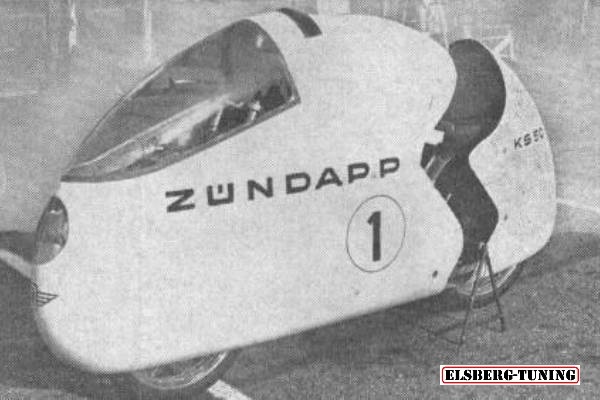 |
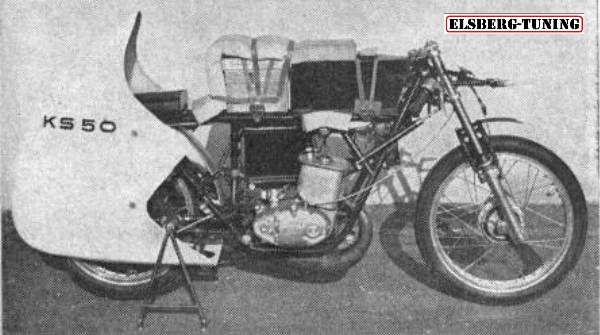 |
The new records were as follows. 10 km : 153.452 km/h (old: 151.00 km/h) classes 50 and 75 cc 100 km : 162.002 km/h (old: 158.67 km/h) classes 50 and 75 cc 1000 km: 146.639 km/h (old: 117.02 km/h) classes 50 and 75 cc 1 hour : 162.609 km/h (old: 159.11 km/h) classes 50 and 75 cc 6 hours : 147.798 km/h (old: 139.49 km/h) classes 50 and 75 cc 12 hours: 137.039 km/h (old: 113.46 km/h) class 50 cc (old: 114.00 km/h) class 75 cc (old: 114.00 km/h) class 100 cc (old: 133.00 km/h) class 125 cc |
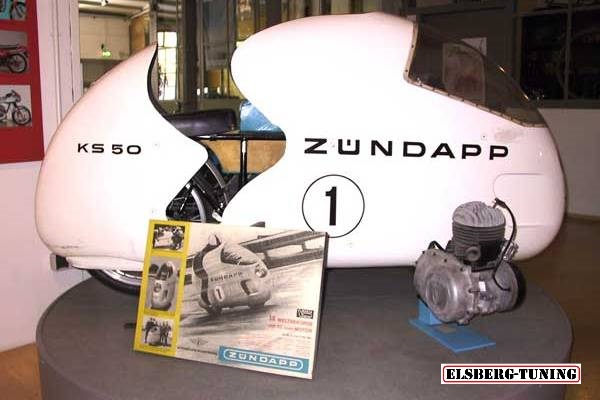 |
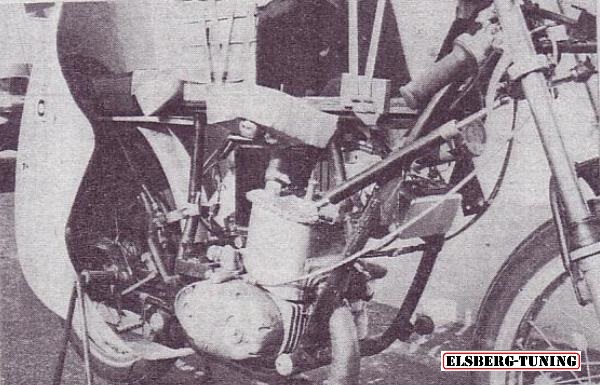 |
The engine was air cooled, and was developed from the trials bike, but was equipped with a rotating inlet disc and a five-speed gearbox, with an extra two-speed box behind it, operated from the left clip-on, just like the Kreidler racers, giving 10 speeds in total. Bore and stroke were 40 x 39.5 mm. Power was given as over 10 bhp at 11,000 rpm. Petrol with an octane number of 98 was used and lubrication oil was mixed with the petrol 1 : 25. The 18" wheels carried tyres specially made by Metzeler, which lasted the whole distance. Total weight was 82 kg.
On 14 May Volker Kramer broke the records over 1 hour and 100 km. The engine used for this had water cooling and was slightly more powerful (500 rpm more). The fairing was closed for better streamlining - the radiator was cooled with a little, battery driven fan. Using the same engine, on 15 May Volker Kramer broke the record over 10 km. J.Kortekaas 2006 |
Utah, october 65 Learning from NSU, Kreidler returned with a very aerodynamic shaped vehicle, powered by a supercharged version of their dual- discvalved engine. Rider Rudolf Kunz piloted the Vaifro Meo designed streamliner to eight new records at the Bonneville salt flats. The supercharged engine received a new handfull of ice, into the cylinder and head cooling cavity, before each take off. |
|
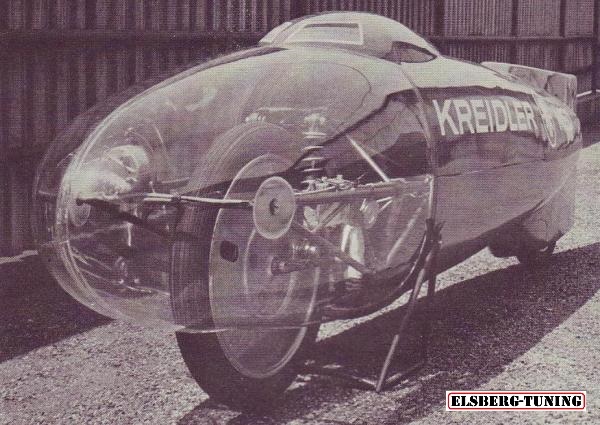 |
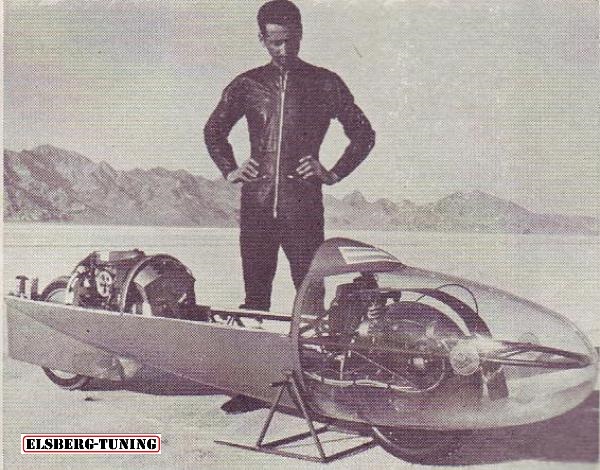 |
 |
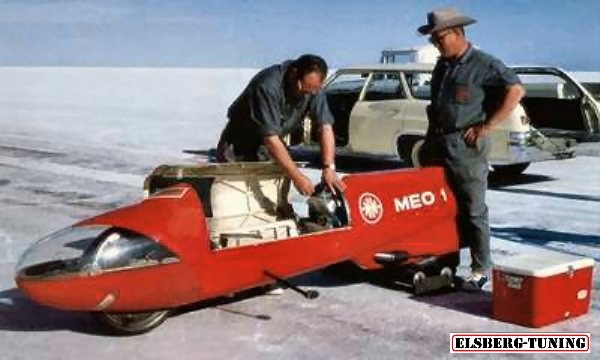 |
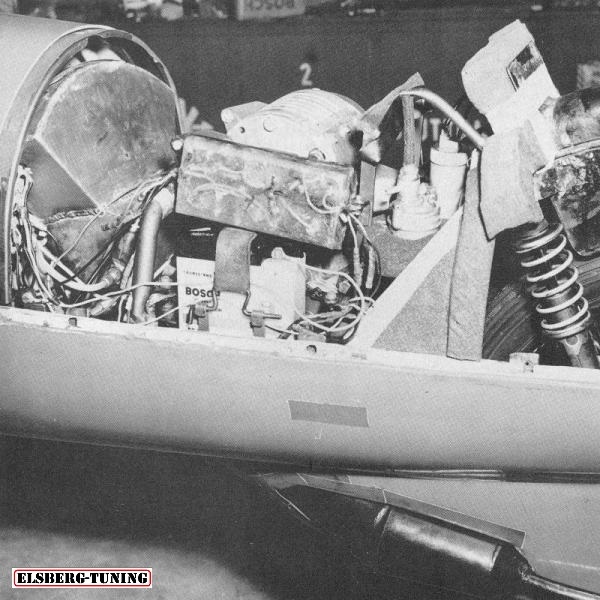 |
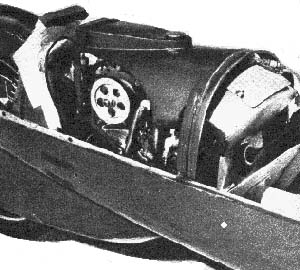 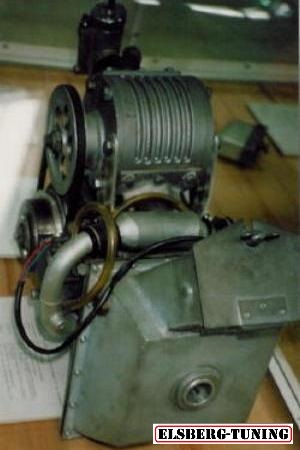 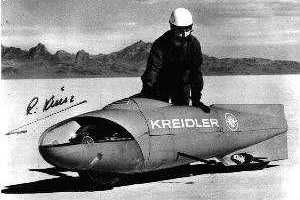 Watch and listen ! |
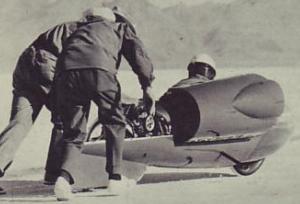 Solution - no more ice! |
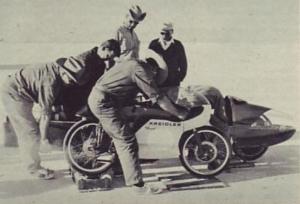 Roller-start |
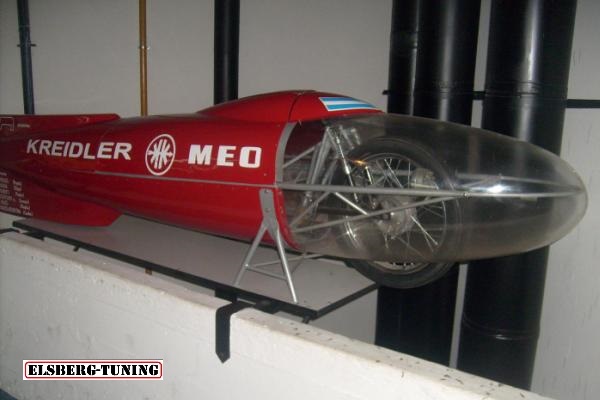 |
The second of the two Meo- Kreidlers now resides in the Fangio Museum. |
1967In 1967 Signore Minarelli hired Otello Buscherini to ride their record- special, a membrane controlled 2- stroke with 4- speeds. Buscherini, weighing just 48 kg, did beat Kreidlers record from 1965, covering the quartermile in just 18:80:50, trapspeed 77,022 km/h. |
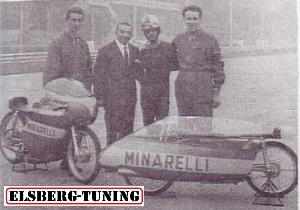 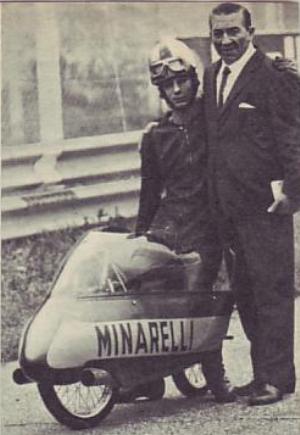 |
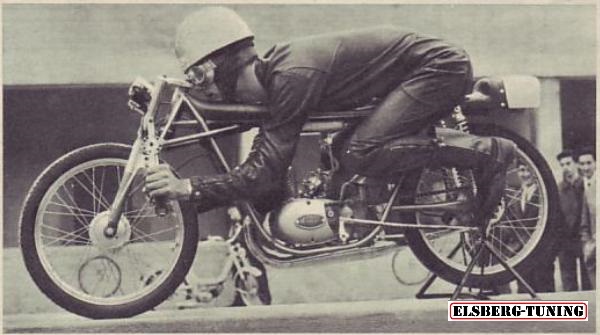 |
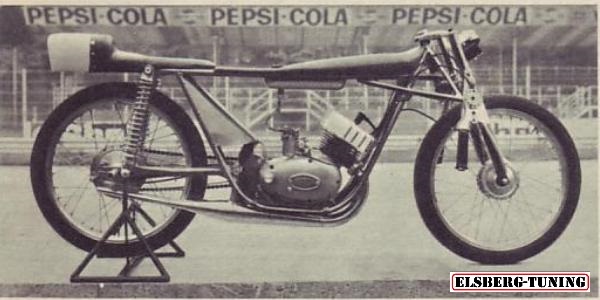 |
 |
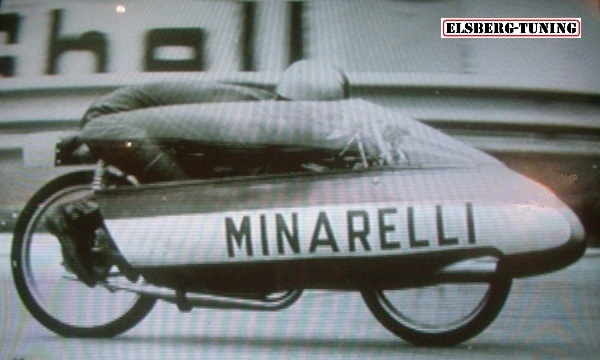 |
| Information regarded this Guazzoni streamliner wanted. | 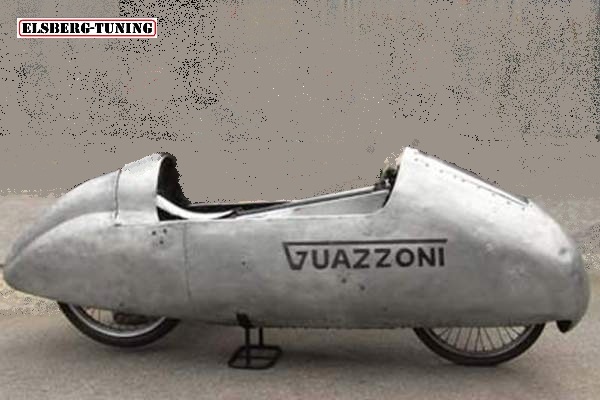 |
| On Sept 19th 1967 Kreidler tried to get back the 6 hr record with a now red coloured bike ridden by Jan deVries and Rudolph Kunz. Due to bad weather the attempt to regain the long distance records failed. | 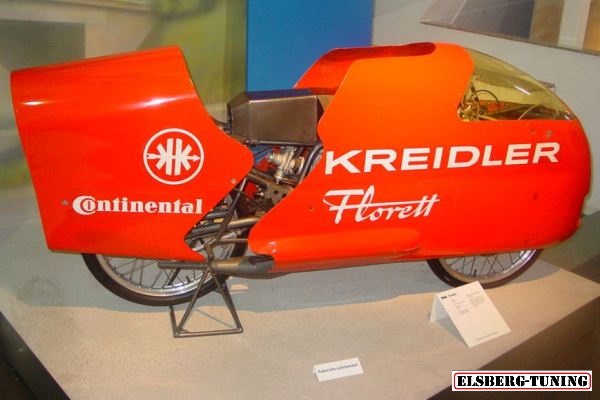 |
1968The annual sprint meeting held at the Elvington airfield, did attract 50cc racers too. In 68 the Van Veen brought their latest sprinter hoping to break several records. They did! Aalt Toersen broke three records : The standing 1/4 were done in 15,568s at 57,8mph. Standing kilometer : 30,318s at 73,8mph. And standing mile : 44,39s at 81mph. The bike shown with swingarm front- suspension were used for initial test on Zandvoort circuit |
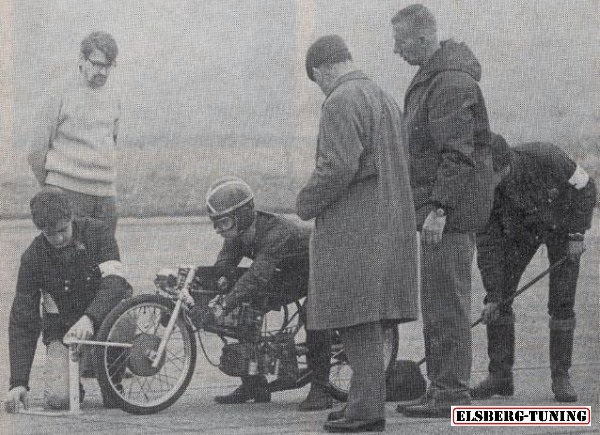 |
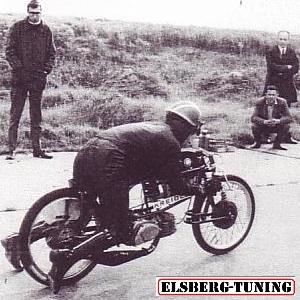 |
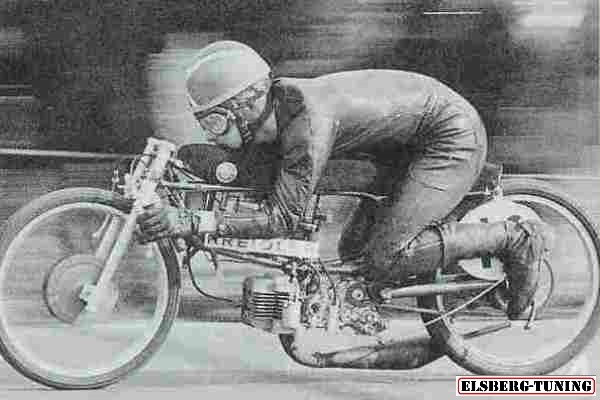 |
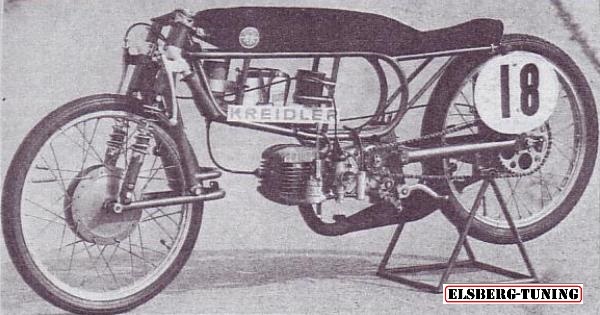 |
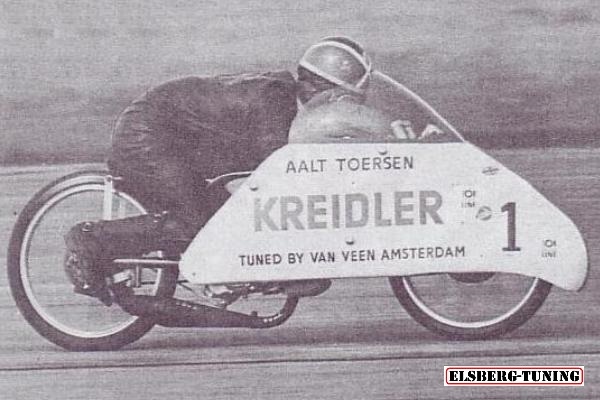 |
1969 |
|
1977In 77 Henk van Kessel rofde the Piet Plompen built Black arrow down a straight in Apeldoorn, and broke Kreidlers 1000m speedrecord. They did 214.6895 km/h and on the return run 228.4829 km/h, so the new record was 221.5861 km/h. Ton Kooyman 2010. 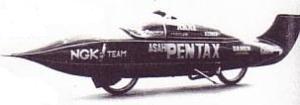 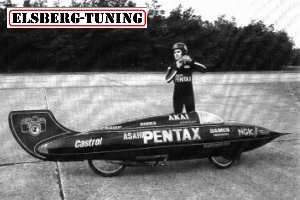 |
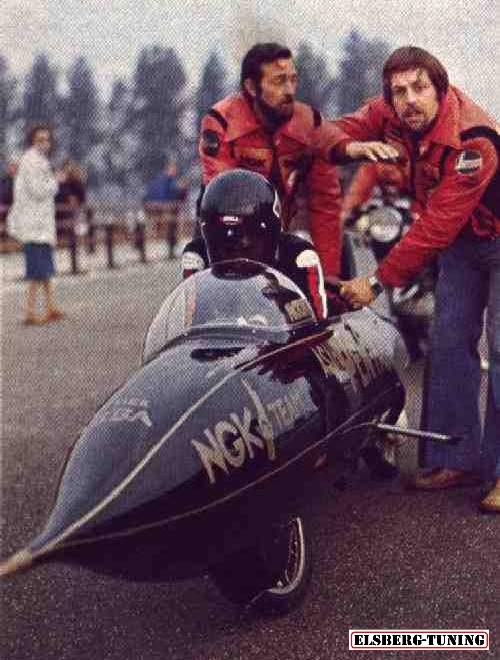 |
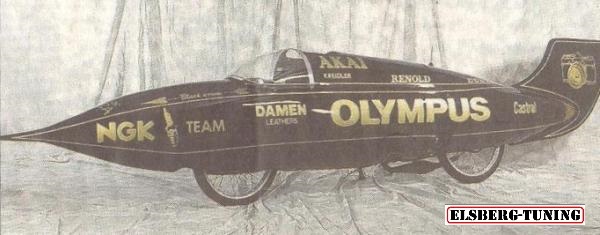 |
|
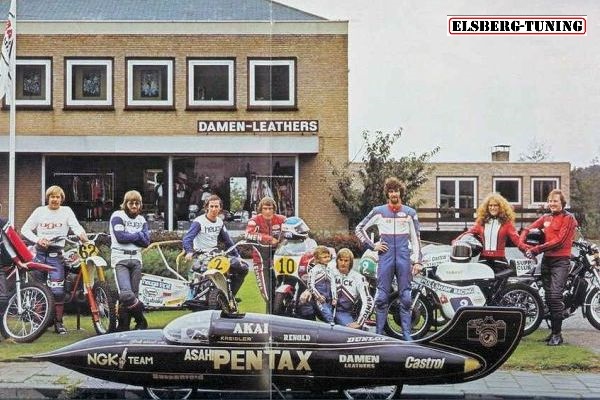 |
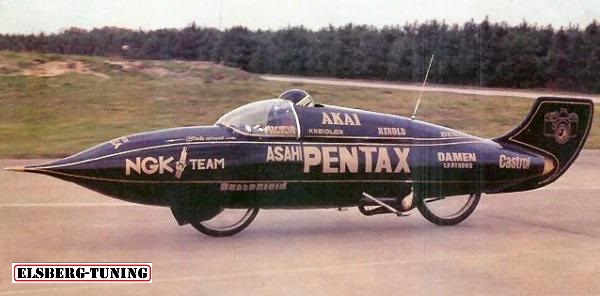 |
1980Jan Nijhuys took a record in 1980, the standing- start 1/4 mile with this bike called Casal Sparta Plompen. Quarter mile was covered in 15,26 seconds and record speed after 402m where 94.29km/h. |
|
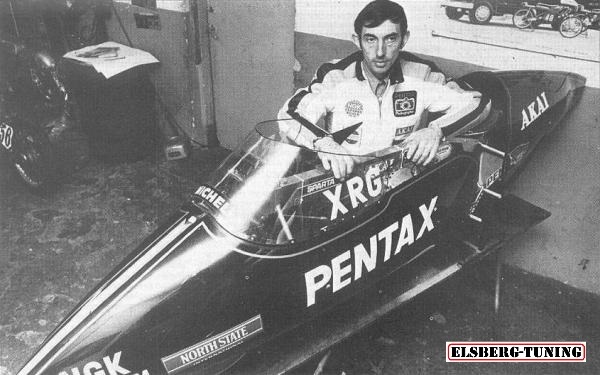 |
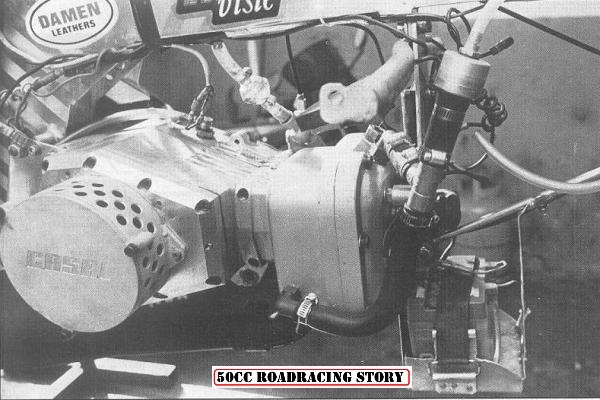 |
1981The Dutch bettered the 50cc speed record with this HuvoCasal ridden by Jan Huberts to 224 km/h. 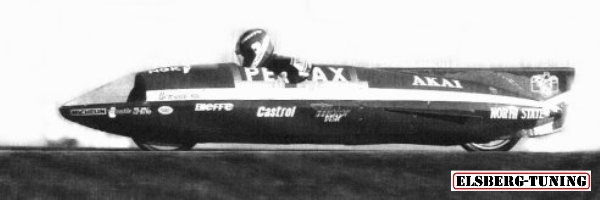 |
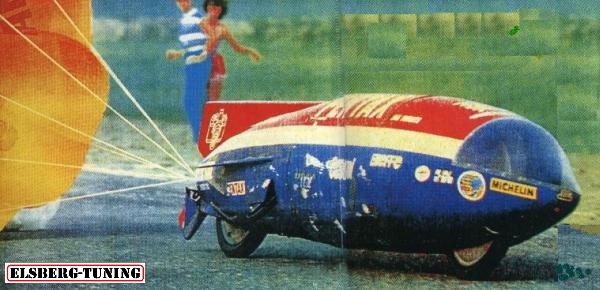 |
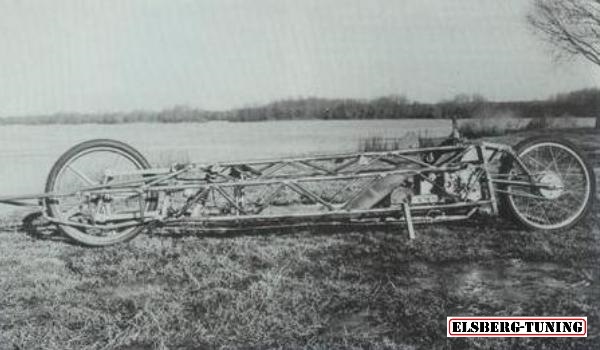 |
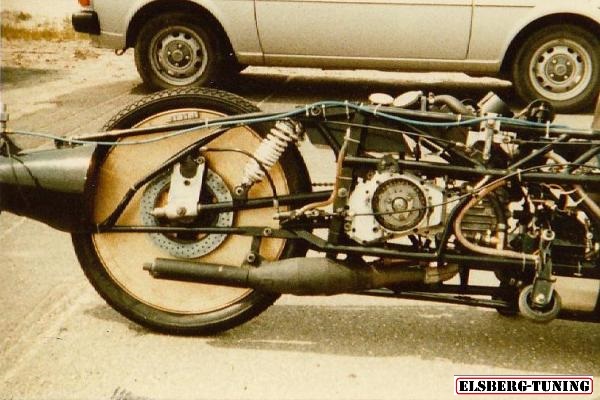 |
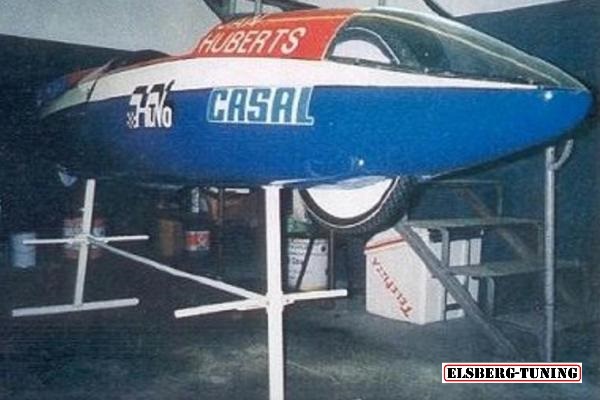 |
The Casal-Plompen world record breaker, as you can see it probably has the same engine as the Sparta, except this one used a Kreidler cylinder.
So the whole thing has technically nothing to do with Casal, i understood that rider Jan Huberts got money from Casal in Portugal to beat the 50cc world record.
Jan had a bussines named HuVo (Huberts-Voskamp), who builds the HuVo-Casal productionracers, Piet Plompen and his team builds the "cigaar" (for money !! )
Jaap Voskamp worked before for Van Veen as you will know. So you can see, the record goes to where the money comes from (with a Kreidler cylinder, HiHo, and more ? ) T. Kooyman 2007 |
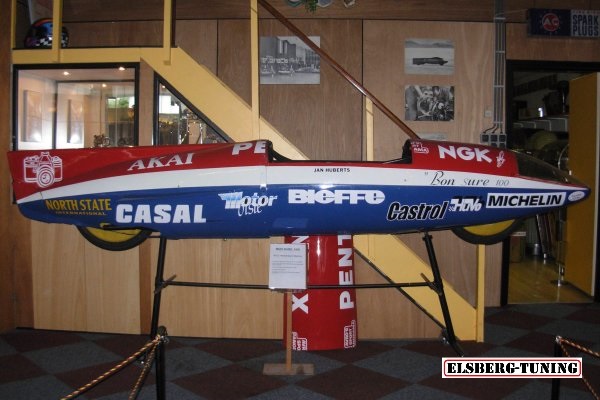 |
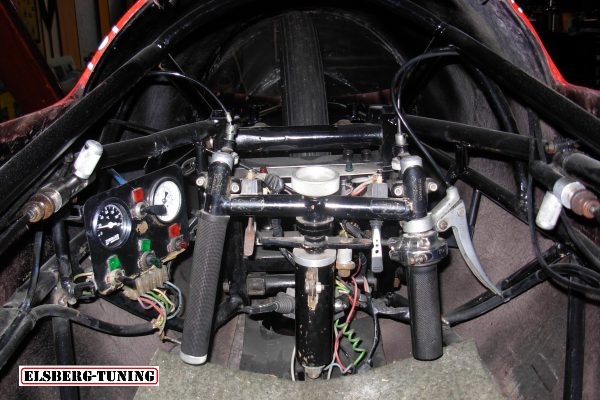 |
1984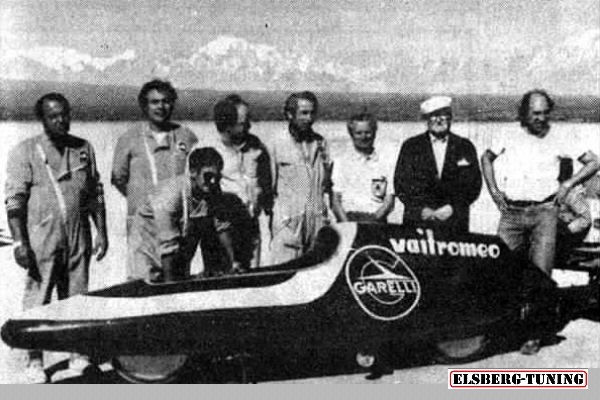 |
In 1984 Vaifro Meo teamed up with Garelli for another attempt at the 50cc LSR. Jan Thiel was there: "As a boy, I was still going to school, I read about Vaifro Meo beating the 50cc world record with an Alpino. So you can imagine how I felt when he came to Garelli, asking to be lent an engine for a new world record attempt! He was one of my boyhood's hero's! Vaifro visited us a couple of times and finally Garelli decided to help him. I was very happy about this, he was very enthousiastic and also a very nice person. He wanted to beat Kreidler because they had treated him very badly. He had build the record machine with which Rudolf Kunz beat the word record at Bonneville. In fact he had been promised the ride but the Kreidler people wanted Kunz to 'test' the machine first. During this "test", Kunz beat the record and Kreidler packed up, leaving Vaifro without a ride! What a shame! And this after him building the machine and even a spare one! But he still wanted the record and together with his friend Perales he started the construc- tion of e new machine. It was decided to make the record attempt in December 1984 at the Pampa del Leoncino, near Barreal. This is a dry lake at an altitude of about 2000m. This altitude gives an aerodyna- mic advantage, but is very bad for engine power. How bad I did'nt realize at the time, having no previous experience, but I soon discovered! Vaifro had even taken a portable dyno to Barreal, at great difficulty. When we tested the engine, which in Italy gave about 21HP we saw only about 12HP, an incredible loss! We tried to improve this using alcohol and nitro, but improved only to about 15HP". |
"Vaifro's chief mechanic Marcello Quintana had prepared something special however, a NOS (Nitrous Oxide) injection which gave a dramatic improvement. To fit the injector we had to fit a longer inlet rubber, the now longer inlet tract made a longer inlet timing necessary, which made the engine a lot more difficult to start. This became a big problem! When it started it gave about 23-24HP, quite incredible. This means that at sea level we would have had maybe 30HP! The engine was then fitted into the machine to start track testing. We tried to start the engine on a roller driven by a car, but this proved impossible. It was then decided to trail the record machine behind a motorcycle to get it started. It was during this trailing that Vaifro crashed. During the crash the machine lost the top half of the fairing and Vaifro also lost his helmet, - he was killed instantly. Nobody saw it happen, so exactly why he crashed will never be known". "It was one of the saddest things that ever happened in my life". Jan Thiel 2010 |
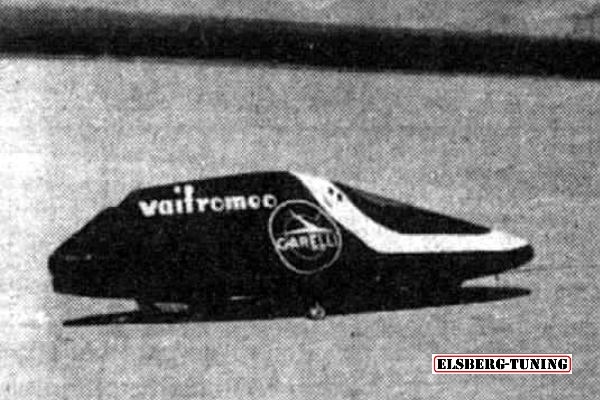 |
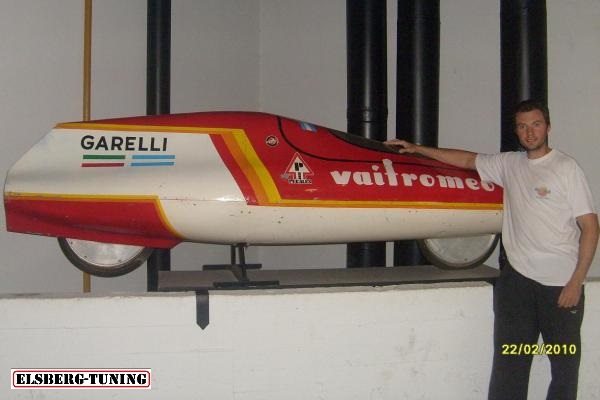 |
Federico Berkelaar visited the Fangio Museum and found the Meo- Garelli. It turned out to be an empty shell on display. |
 |
And of course, the record hunt never stops. The myriads of different classes in LSR- racing are from time to time visited by 50cc machinery. Some of them will be described here |
|
| Enter John Buddenbaums Minarelli AM6 powered streamliner! John Buddenbaum has set his sight on the 50cc topspeed record and broke it big time ! With current setup, a turbocharged AM6 engine fed by methanol, the Buddfab streamliner managed a speed of 233,3km/h! |
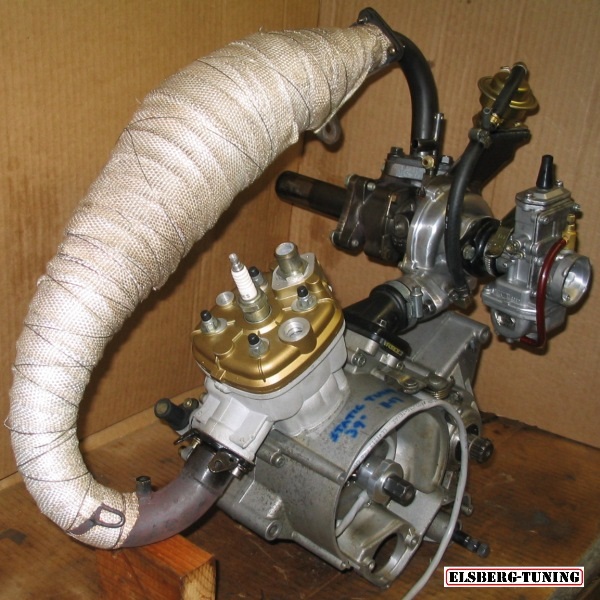 |
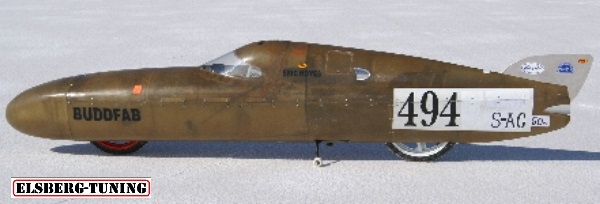 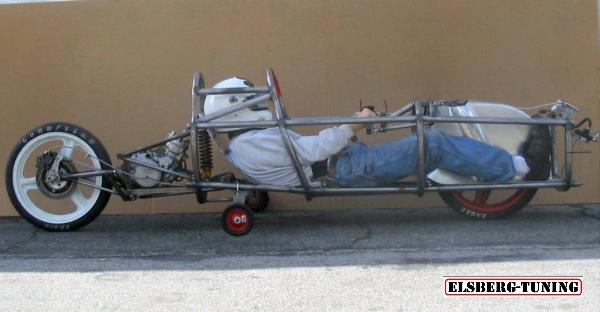 |
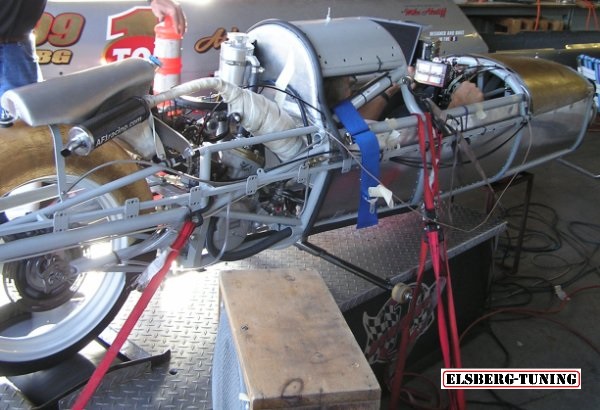 |
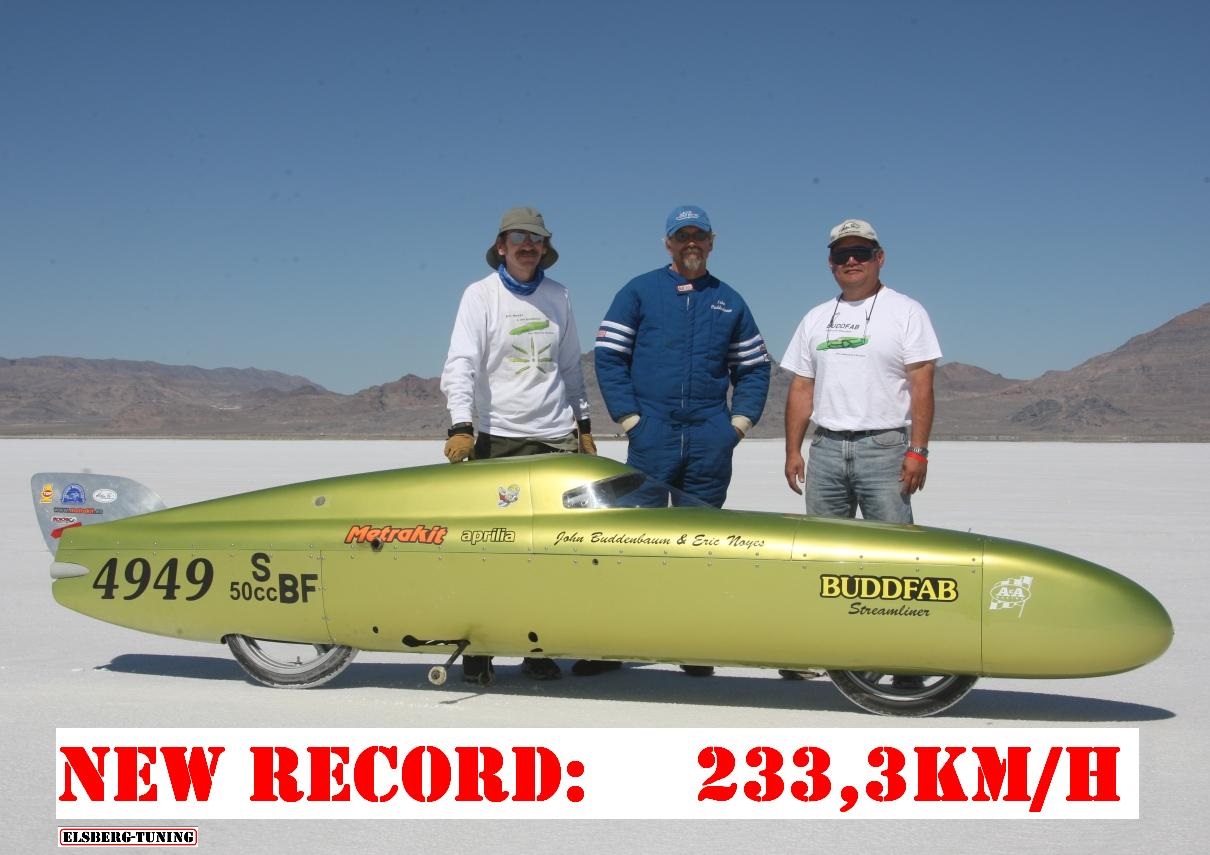 |
More info:Visit Buddenbaum´s sitehttp://www.geocities.com/buddfab/buddfab3 http://www.youtube.com/watch?v=1U4bOtifdFU |
| Another 50cc team: Owner and builder Eric Manning and rider Andy Sills competes in the modified partially streamlined methanol- fueled class. |
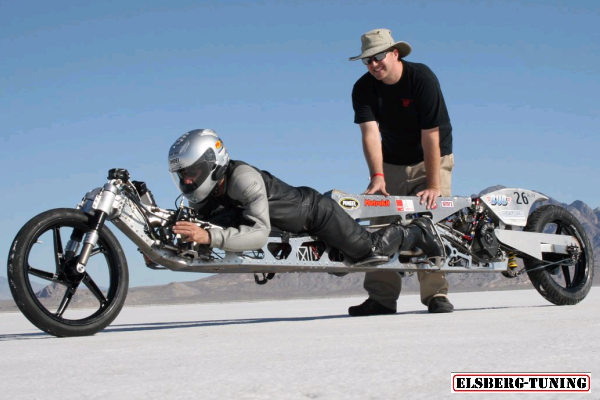 |
Will the Dutch regain their record in 2014?Follow a dedicated LSR- team with Aalt Toersen at the controls: http://www.groene-tulp.nl/cms/ |
|
| Following tables shows the myriad of classes in LSR racing. | 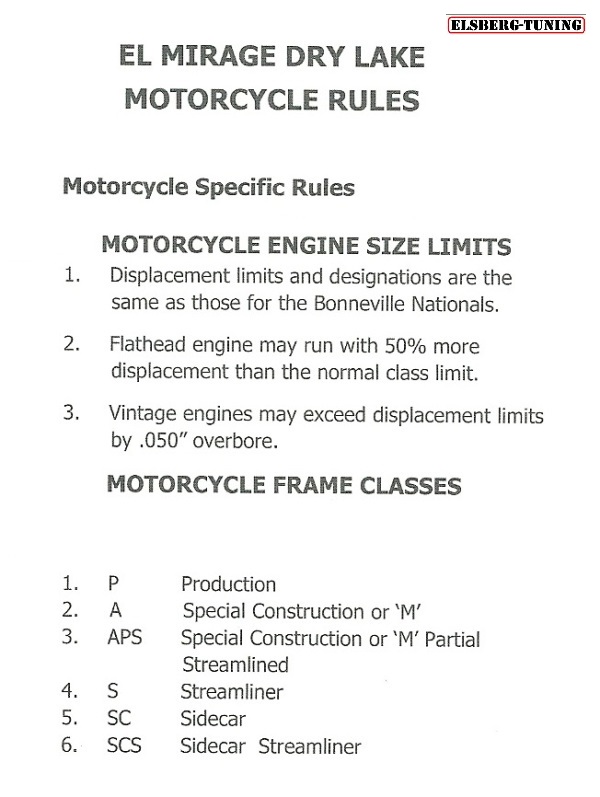 |
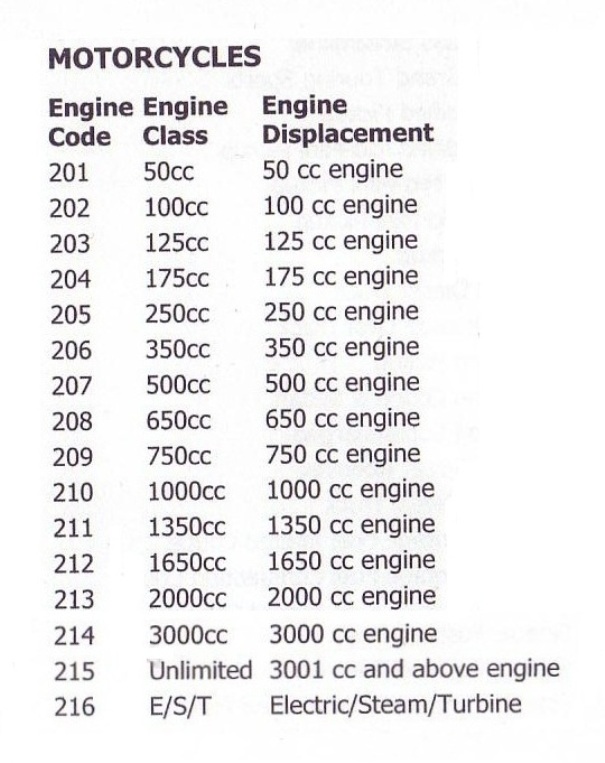 |
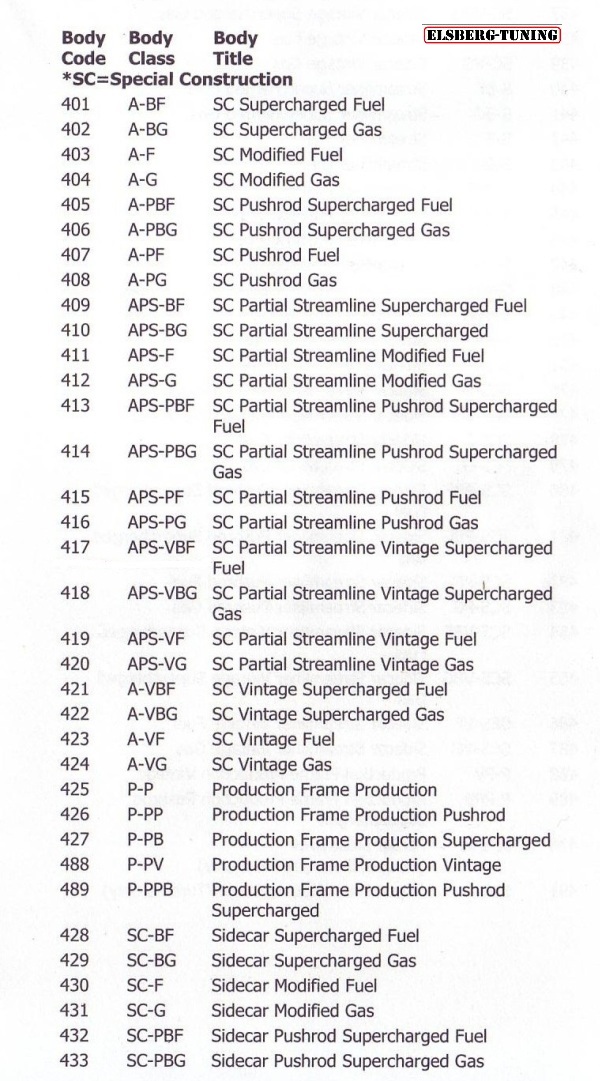 |
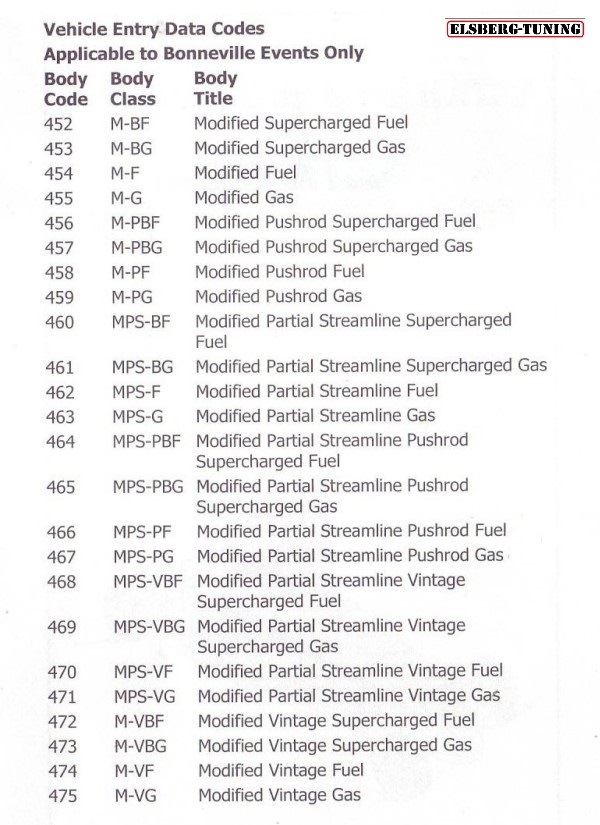 |
|
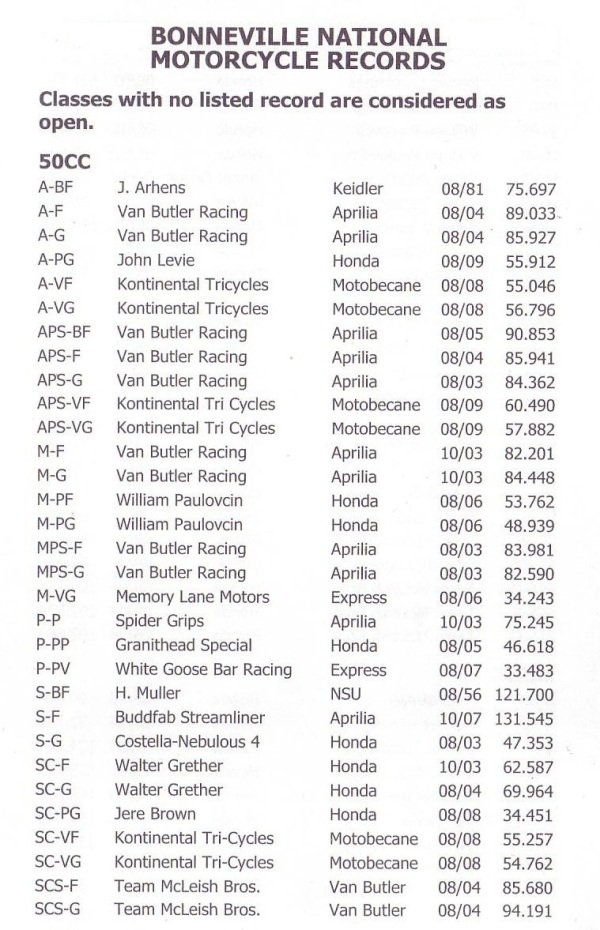 |
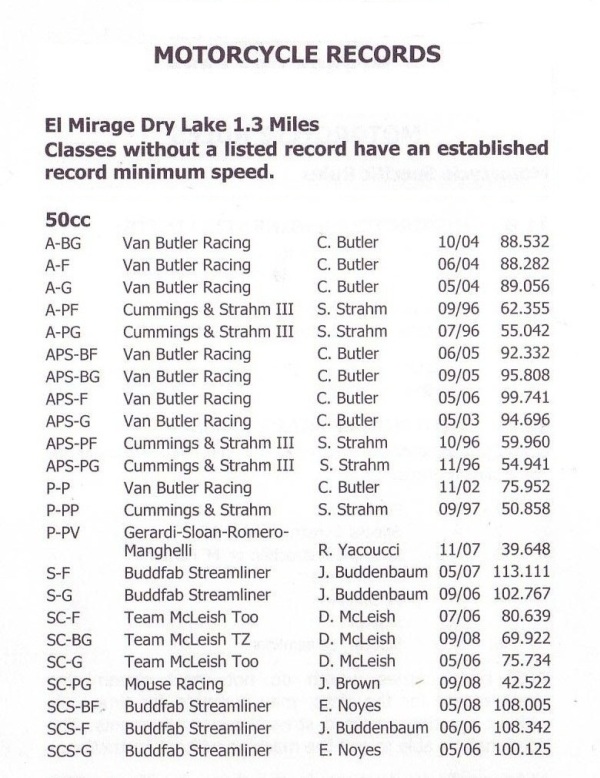 |